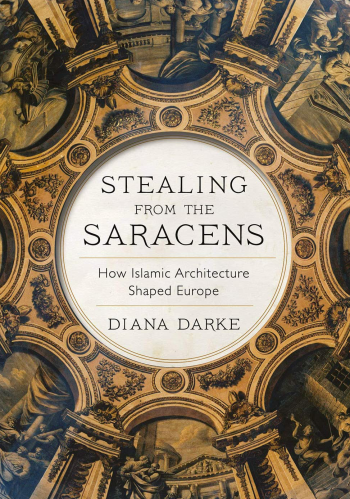Stealing from the Saracens: how Islamic architecture shaped Europe
Stealing from the Saracens: how Islamic architecture shaped Europe, Diana Darke, Hurst Publishers, London 2020, 474 pages, 7 black-and-white and 146 colour illustrations.
Andalusia, Sicily and Venice are widely recognised as main gateways through which the stylistic, scientific and linguistic traditions of Islam first entered western Europe during the middle ages. Since then, generations of travellers have flocked to Córdoba’s Mezquita, La Cuba in Palermo and Piazza San Marco to absorb their oriental flair. It dawned on some of them that the pointed arch, quintessential of both Islamic and gothic designs, could be traced back to the middle east, where it must have been spotted by crusaders and pilgrims before. The shared architectural heritage of Christendom and Caliphate evolved in very different directions, but that is not the subject of this book, which makes a passionate address to the Europeans to stop them ‘airbrushing from history their cultural debt to the Muslim world’.
It is debatable whether the knowledge of Islamic heritage in Europe faces elimination. The growing interest in Islamic cultures across western society seems to tell a rather different story. Nevertheless, the author, Damascus-based British Arabist Diana Darke, is on a mission to rehabilitate Islamic design and construction as founding stones of European architecture. Her publication whets the appetite of academics and professionals alike, only to surprise with the statement: ‘It does not greatly matter exactly how the pointed arch entered Europe – there were numerous possible routes’. Architects, archaeologists and art historians were hoping for more solid evidence, and when it is forthcoming it does not always satisfy.
The comparison between the rib-vaulted 15th-century chapel of King’s College, Cambridge and Bab al-Mardum Mosque, Toledo (built 998-1000, now Cristo de la Luz), for instance, would benefit from in-depth discussion to demonstrate how they are technologically linked. Instead, the curious reader finds the juxtaposition towards the end of a hundred pages on the history of Umayyad architecture. More focus on fewer samples might have done the trick. Even the methodology appears hasty. Encouraged by Christopher Wren’s learned suggestion that the ‘Gothick’ be renamed ‘Saracen Style’, the author defines 27 key features of Islamic/ middle eastern origin, affiliating iconic gothic buildings that display any of them.
Darke’s universal mindset is commendable and her enthusiasm genuine. If you wish to join her travel around Europe and the Mediterranean, frequenting more than 15 centuries and just as many disciplines, this book is for you. The bibliography’s academic credentials might need reinforcement (adding references to Thilo Ulbert, authority on repeatedly mentioned Rusafa- Sergioupolis, for example) but the author’s dedication to Syria, where she has been living for over 30 years, is of course justified. 5th- and 6th-century churches in the abandoned Ancient Villages of Northern Syria (a world heritage site since 2011) are known for their contribution to Romanesque design.
The author widens the perspective to include the entire Muslim hemisphere, itself heavily indebted to Syrian masons. It may be more fitting, then, to acknowledge those as agents of innovation whom medieval sources link to Syria (including Palestine), whether they might be identified as pagan, Jew, Christian or Muslim, and their style as Hellenistic, Roman, Byzantine, Umayyad, Abbasid, Fatimid, Seljuk or Ottoman. Learning from the Syrians, perhaps, rather than stealing from the Saracens.
This article originally appeared as ‘What the Syrians did for us’ in Context 169, published by the Institute of Historic Building Conservation (IHBC) in September 2021. It was written by Michael Asselmeyer, architect and historian.
--Institute of Historic Building Conservation
Related articles on Designing Buildings
IHBC NewsBlog
Old Sarum fire in listed (& disputed) WW1 Hangar - Wiltshire Council has sought legal advice after fire engulfed a listed First World War hangar that was embroiled in a lengthy planning dispute.
UK Antarctic Heritage Trust launches ‘Virtual Visit’ website area
The Trust calls on people to 'Immerse yourself in our heritage – Making Antarctica Accessible'
Southend Council pledge to force Kursaal owners to maintain building
The Council has pledged to use ‘every tool in the toolbox’ if urgent repairs are not carried out.
HE’s Research Magazine publishes a major study of the heritage of England’s suburbs
The article traces the long evolution of an internal programme to research 200 years of suburban growth
IHBC Context 183 Wellbeing and Heritage published
The issue explores issues at the intersection of heritage and wellbeing.
SAVE celebrates 50 years of campaigning 1975-2025
SAVE Britain’s Heritage has announced events across the country to celebrate bringing new life to remarkable buildings.
IHBC Annual School 2025 - Shrewsbury 12-14 June
Themed Heritage in Context – Value: Plan: Change, join in-person or online.
200th Anniversary Celebration of the Modern Railway Planned
The Stockton & Darlington Railway opened on September 27, 1825.
Competence Framework Launched for Sustainability in the Built Environment
The Construction Industry Council (CIC) and the Edge have jointly published the framework.
Historic England Launches Wellbeing Strategy for Heritage
Whether through visiting, volunteering, learning or creative practice, engaging with heritage can strengthen confidence, resilience, hope and social connections.















